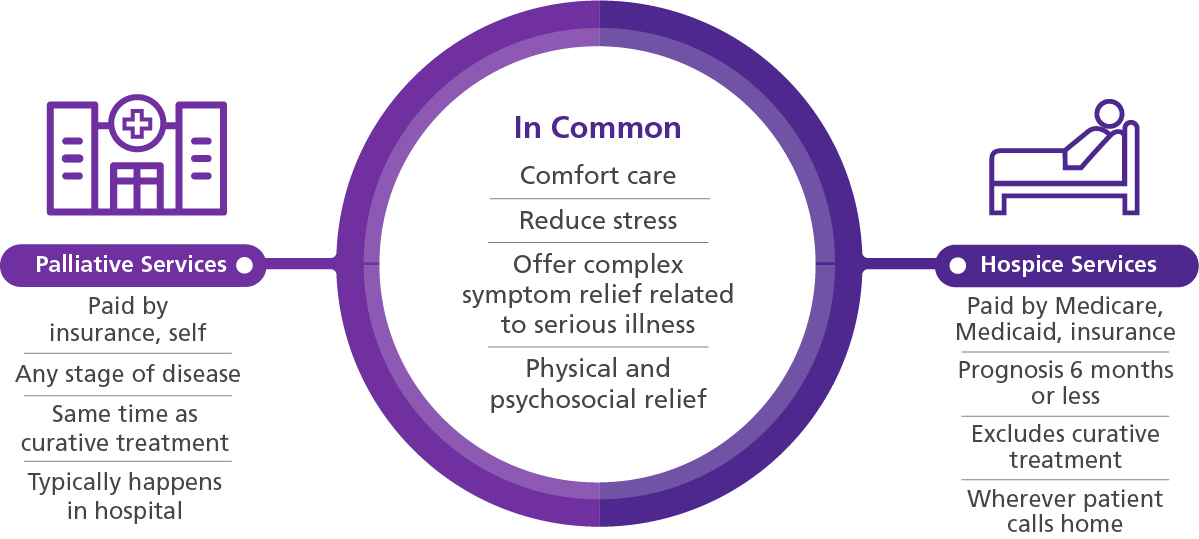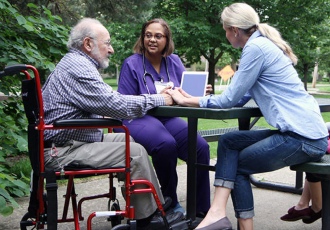A Helping Hand When You Need It the Most
The first time he spoke to a VITAS physician, Jim Forrester’s list of requests was short.
He wanted to sleep through the night, he said. He wanted to walk again.
“What else would you like?”
“I’d like to feel happy.”
These felt like big asks. Forrester, a retired firefighter, was determined to spend the final months of his life in the San Clemente, California home where he’d fostered puppies for Guide Dogs of America, been a regular babysitter for his four young grandchildren, and settled into retirement with his wife, Debbie.
But the advancing course of his illness—squamous cell carcinoma, a skin cancer that spread throughout his body—had sapped much of his energy and necessitated a leg surgery from which he had been slow to heal.
He couldn’t get out of bed, but he couldn’t sleep. He’d lost his appetite, shedding 30 pounds in a matter of months. Everyday activities such as showering and making a cup of coffee had become impossible without another person’s assistance—and Jim, long accustomed to being the rock of his family, despaired every time he needed to ask for it.
The Forresters were told that Jim had six months to live, give or take. They wanted his remaining time to be better than this.
He enrolled with VITAS Healthcare that Tuesday night. He told VITAS Physician Thomas Bui, MD, what he wanted: Sleep. Mobility. Optimism that his remaining time could be spent doing things, not waiting for them to happen to him.
“I can make that happen,” the Forresters recall Bui telling them. “We can put all that together in a medication plan, and the nurses can help me with that."
The plan came through the next day; the medication arrived shortly after that. Debbie found him at the top of the stairs the following morning.
"How did you get up there?" she said.
"I walked.”
Transforming the End of Life with VITAS
Jim’s time is still limited. But the person-centered care available through hospice with VITAS enables him to choose how it’s spent, access the mental and spiritual care he needs, and set his own goalposts for success.
“I look back now, three months ago, how I felt—from having some pain, being down with my cancer—to being lifted up now, to feeling like I did a long, long time ago,” he said. “I feel so much better. Every day I wake up is a new day, and I enjoy the day.”
The decision to seek out hospice care was an easy one, the Forresters said, and they made it early. Jim’s 33-year career as a firefighter brought him into contact with end-of-life patients more than occasionally, and he believes his own father could have benefited from more than a week of hospice care before his death.
I wanted the benefits of it and, fortunately, it has come to make a huge difference.-Jim Forrester
It was a personal decision supported by data: Multiple studies found that greater utilization of hospice during the last six months of life is associated with increased satisfaction and quality of life. These studies indicate longer stays amount to better outcomes, fewer hospitalizations and less strain on caregivers.1-5
“I have experienced too many people that waited way too long to access it,” he said. “I wanted to access it as soon as the doctors told me that I had a short period of time to live. I wanted the benefits of it and, fortunately, it has come to make a huge difference.”

He’s cycling again with the help of a comfort-focused medication plan and an electric bicycle. He and Debbie enjoy welcoming guests for a family dinner every Sunday, along with frequent visits from a VITAS hospice nurse who ensures Jim’s care plan is still working for him. His dogs—“his babies,” Debbie says—are making up for the playtime they missed.
So are his grandchildren.
[With VITAS,] Jim became the person that we all knew again.-Debbie Forrester
“It's such an enjoyment now for me that I can see them,” he said. “I’ve taken it for granted, that they're always going to be around me and growing up, and now I have to step back and say, ‘They might not be around me forever, so let's enjoy what we can right now.’ It's been really nice with my mental attitude changing in the last couple of months.”
SIDEBAR [picture a separate text box with the main article wrapping around it] : Each VITAS care team comprises physicians, nurses, chaplains, social workers, and home health aides, all of whom work together to develop individualized care plans guided by the patient and family’s care goals.
Feeling more in control of his future—able to steady his own ship, if not change its course—has helped Jim feel better about himself, Debbie said.
“He is not used to people taking care of him, so it was really hard” earlier in his disease trajectory, she said. “He didn't like to be burdening us. [With VITAS,] Jim became the person that we all knew again. He was that tough fireman calling the neighbor next door, asking him if he could roll his trash out. Just amazing things.”
'Such a Relief’ for the Caregiver
Debbie, too, feels steadier now. She had been her husband’s primary caregiver throughout his illness, a role that required her to act as intermediary between her husband and a half-dozen specialists while also managing his care at home.
Even with support from friends and family, she struggled.
I just know that all I have to do is reach out and someone's going to pick up on the other line and fix it or try to fix it. This has been such a relief. -Debbie Forrester
“I think the hardest thing about the caregiving was watching him go through the pain,” she said. “The pain was excruciating, and it didn't seem like any doctor really cared about the pain. I was on the phone trying to coordinate one doctor to talk to another doctor to figure out how we could get him appropriately medicated, and I'm just a layperson. I shouldn't have to be taking care of those kinds of things.”
Entrusting those responsibilities to a dedicated VITAS care team—one whose members communicate among themselves, coordinate with Jim’s specialists, center his care goals, and keep in close contact with the family—gave Debbie a chance to exhale.
“I can't even talk about how much impact having hospice and knowing there's somebody here that cares has been,” Debbie said. “I just know that all I have to do is reach out and someone's going to pick up on the other line and fix it or try to fix it. This has been such a relief.”
[insert link about care coordination when staging]
She’s still involved in her husband’s daily care, but now she has a team to fall back on with VITAS hospice services. A vocational nurse helps with wound care. A registered nurse stays in touch to monitor Jim’s overall wellbeing. Both check in with her regularly.
“The VITAS team has been amazing,” she said. “I never feel awkward calling them. Even if it’s the littlest thing, I’ll get a response within minutes.”
Choosing Hospice Sooner and Celebrating Life
The Forresters’ only regret about hospice care, they said, is that they couldn’t start it earlier. They opted in as soon as they could—now, they’re making the most of their time.[insert link about early referrals when staging]
The life they’ve created together includes a community eager to help.
A few weeks into Jim’s time on hospice, a group of friends and former firefighters held a celebration of Jim’s life with him in attendance.
“It's hard to express how much somebody means to you, 30 years later, when somebody has taught you so much about life,” said firefighter Jean Norman. “We always said, ‘Let's get together again. Let's not get together when we have one of these, you know, unfortunate events where we lose somebody.’”
Jean, who credits the Forresters with helping her find a community in her early firefighting career, beelined toward him for a hug.
Pete Peters, another firefighter, told stories about Jim’s firehouse pranks and watching him fall in love with Debbie.
“I could tell right away they were getting married,” Peters said. “It was just that magnetic.”
The couple are still making plans for the future, even if there’s less of it than they once expected. They’ll be retaking their family pictures soon. Jim is enthusiastic about having VITAS create videos to help his loved ones remember their time together.
It's a touchy subject—people don't like to hear that word [hospice]—but when they finally access it and feel the relief that can be provided, it's such a beneficial service.-Jim Forrester
“I would try to encourage anyone who has a family member who is expected to pass away in a short period of time, whatever time that may be, to access hospice,” Jim said. “It's so many different avenues of help. It's a touchy subject—people don't like to hear that word—but when they finally access it and feel the relief that can be provided, it's such a beneficial service.”
It’s exactly what the family hoped hospice would be, Debbie said; exactly the opportunity Jim wanted for himself at the end of his life. It’s a goodbye on his terms, and VITAS ensures he feels well enough to participate in it.
“Really, if you know what your prognosis is and you want the best quality of life, don't fight it,” Debbie said. “I say it’s just been one of the most positive experiences we’ve ever had.”
1Aldridge M., et al. (2022). Association between hospice enrollment and total health care costs for insurers and families, 2002-2018. JAMA Health Forum. 3(2), e215104-e215104).
2Harrison, et al. (2022). Hospice Improves Care Quality For Older Adults With Dementia In Their Last Month Of Life: Study examines hospice care quality for older adults with dementia in their last month of life. Health Affairs, 41(6), 821-830.
3Kleinpell, et al. (2019). Exploring the association of hospice care on patient experience and outcomes of care. BMJ Supportive & Palliative Care, 9(1), e13-e13.
4Kumar, et al. (2017). Family perspectives on hospice care experiences of patients with cancer. Journal of Clinical Oncology, 35(4), 432.
5Wright, et al. (2010). Place of death: correlations with quality of life of patients with cancer and predictors of bereaved caregivers' mental health. Journal of Clinical Oncology, 28(29), 4457.

Tips for Effective Goals-of-Care Discussions
Conduct more effective goals-of-care discussions with your patients by using this conversation starter guide.
Download the PDF Clinicians: Receive Our Newsletters